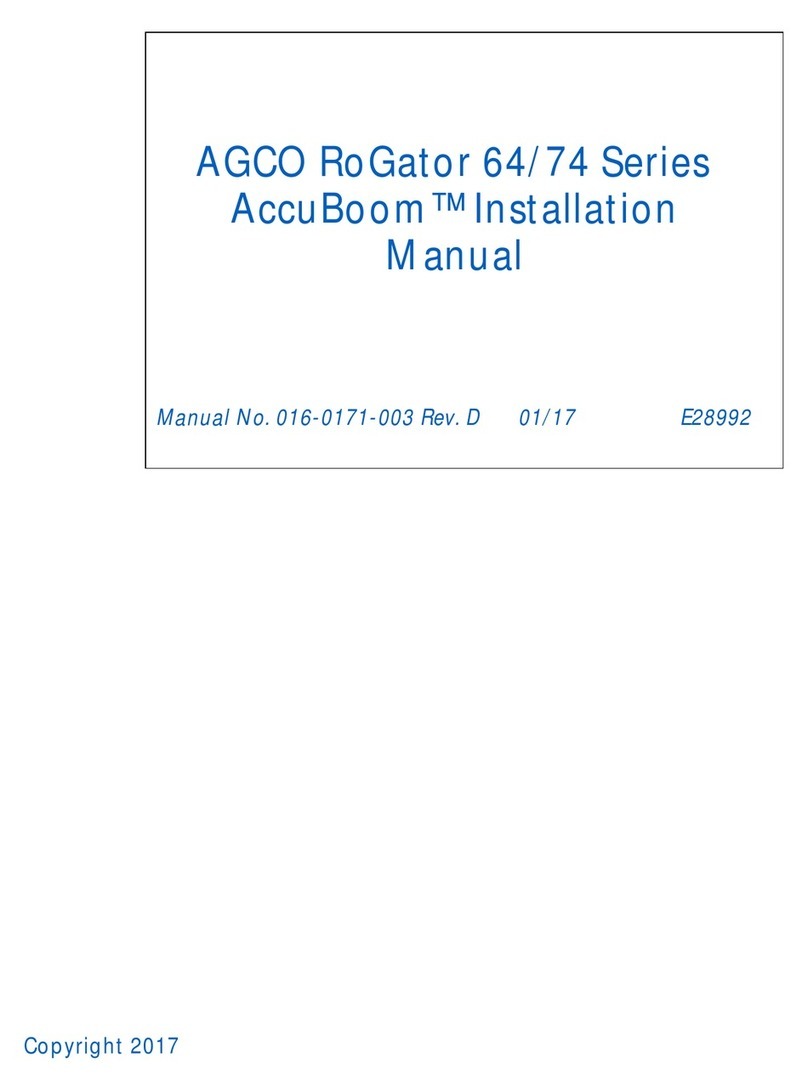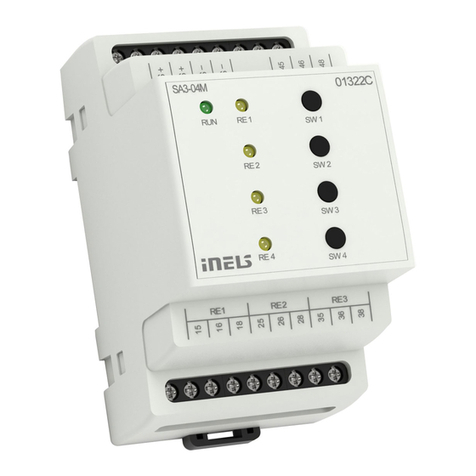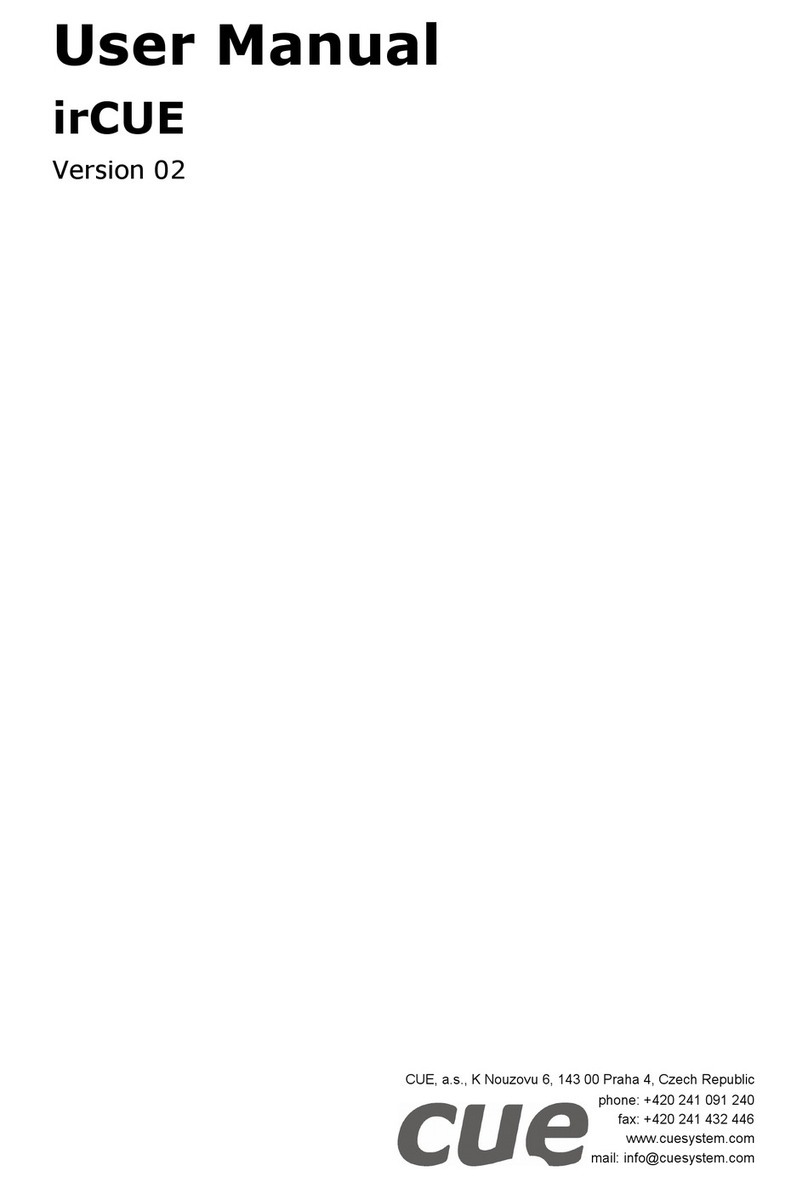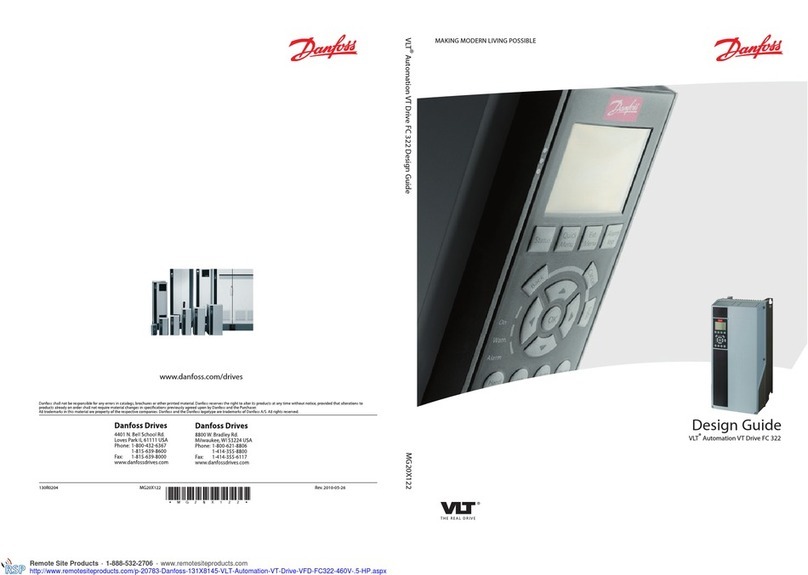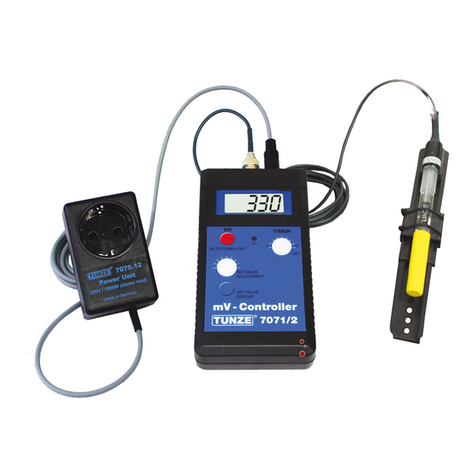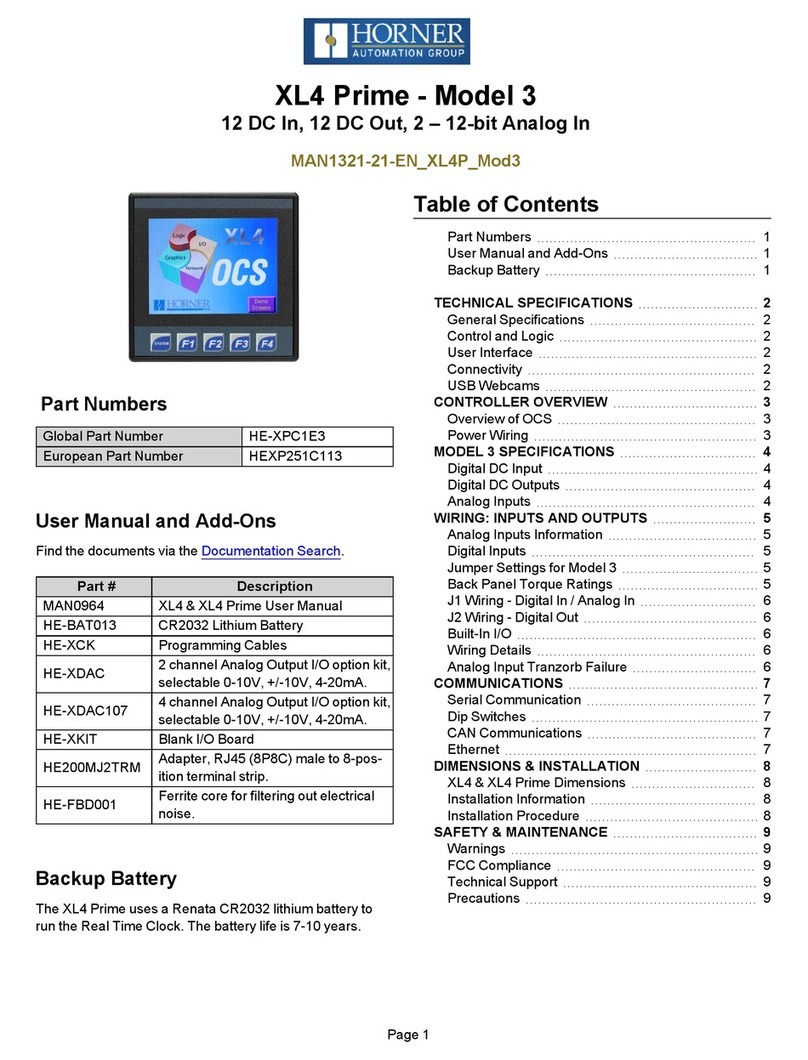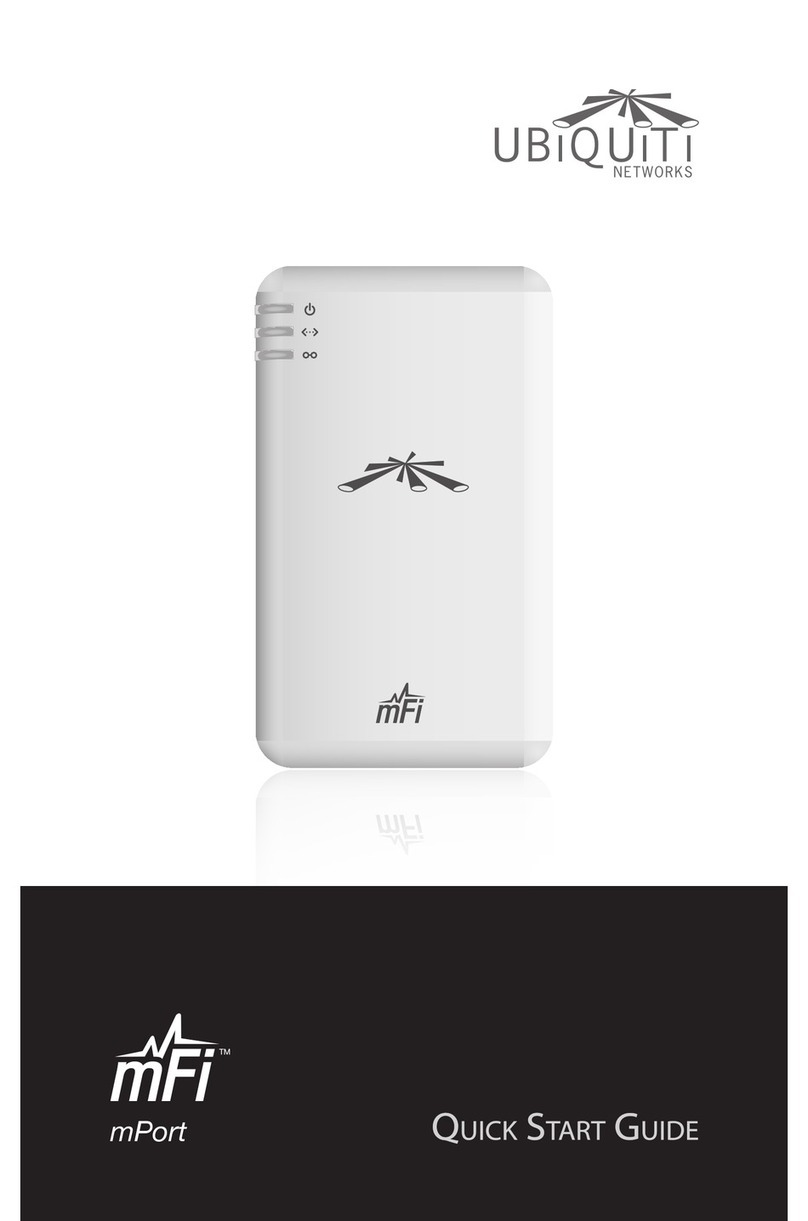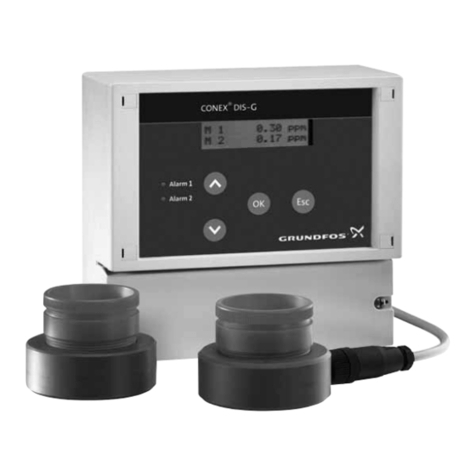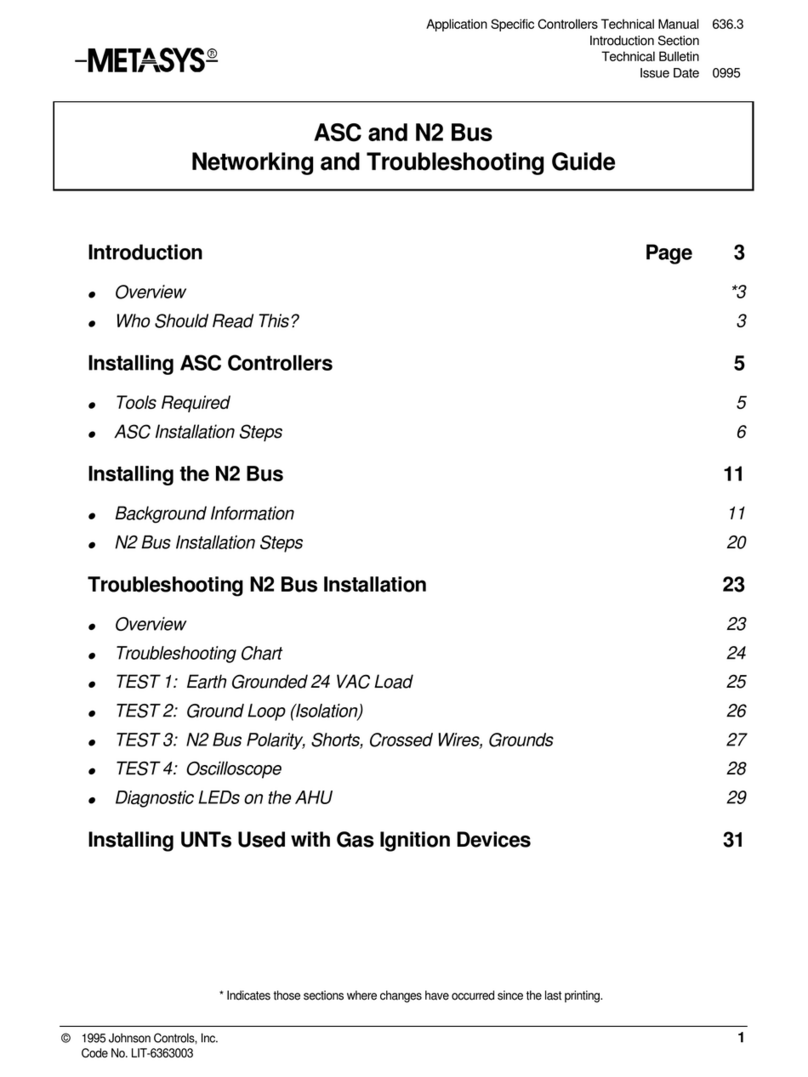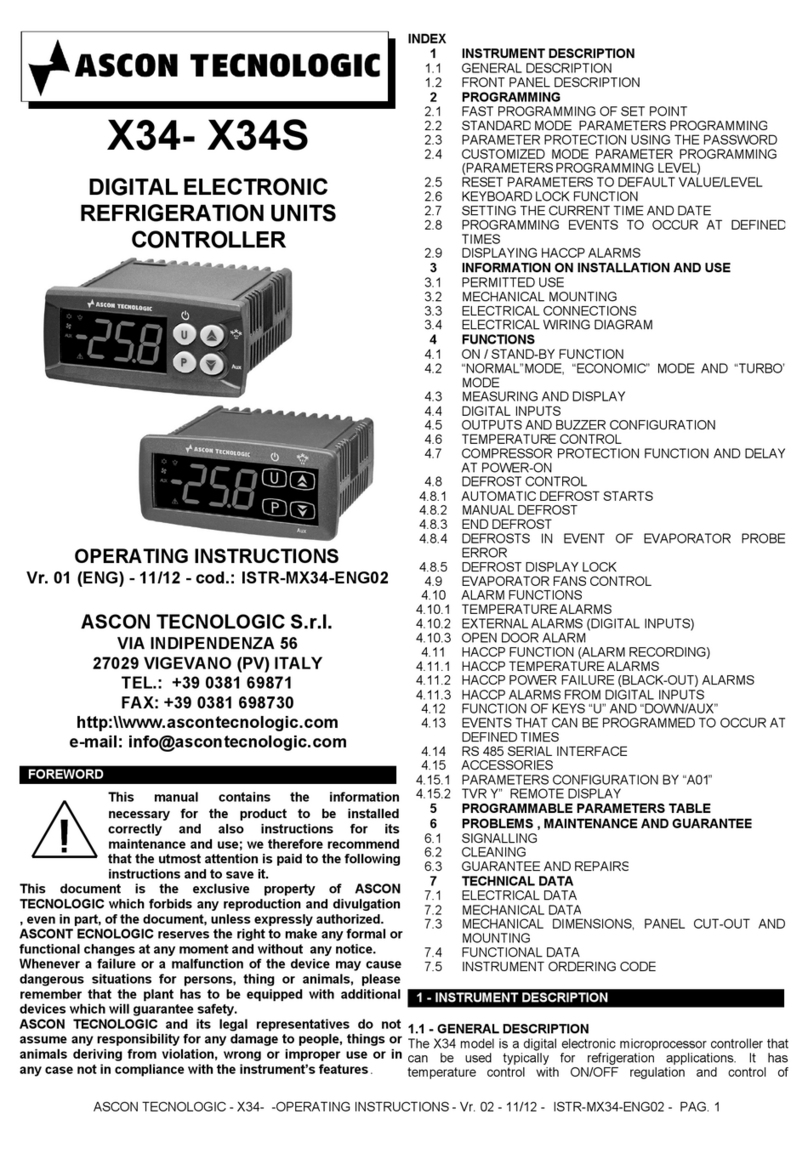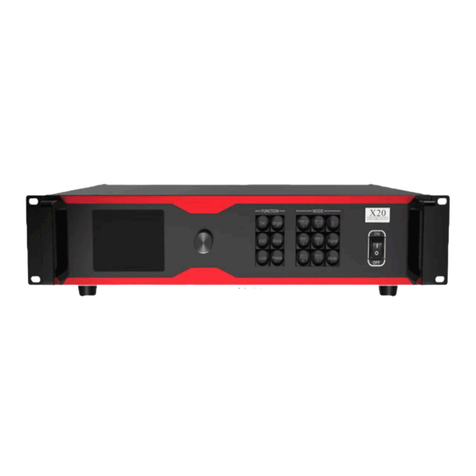Athena Controls 16C Series User manual

16C

2
Congratulations on your purchase of an Athena Series 16C Temperature/Process Controller. It is designed for ease of use and
reliability wherever accurate control is required.
After following the instructions for installation, simply step through and set your operating parameters using the controller’s easy menu
system. The instrument may then be automatically or manually tuned to your process for optimum setpoint control.
As you look through this manual, you will notice
blue italicized text
appearing with, or adjacent to, the operating information. These
notes impart important information about the controller and may answer questions you may have about its setup or operation. If you
still have questions or require any assistance, please contact your Athena representative or call technical support at 1-800-782-6776.
Outside the USA, please call (+1) 610-828-2490.
After unpacking, inspect the instrument for any physical damage that may have occurred in shipping. Save all packing materials and
report any damage to the carrier immediately.
Field-Selectable Inputs including Thermocouple, RTD, Current or Voltage
Process Control via On/Off Through Full PID Operation
Autotuning - Heat or Cool
Eight-Segment Ramp/Soak to prevent thermal shock
On/Off Output with Adjustable Hysteresis and Deadband to maintain tight process control
Field-Configurable Process or Deviation Alarms
Bumpless, Auto-Manual Transfer
NEMA 4X Front Panel, “Watertight”
Selectable Ramp to Setpoint
Alarm Inhibit
Loop Break Alarm Capability
Available Options Include Serial Communications, Contact/ Digital Input, Remote Analog Setpoint, Transducer Excitation, Auxiliary
Output, Dual Alarms, or Electromechanical Relay Alarm.
In addition to presenting a potential fire hazard, high voltage and high temperature can damage equipment and
cause severe injury or death. When installing or using this instrument, follow all instructions carefully and use
approved safety controls. Electrical connections and wiring should be performed only by suitably trained personnel.
Do not locate this instrument where it is subject to excessive shock, vibration, dirt, moisture, oil, or other liquids. The
safe operating temperature range for this unit is 32°F to 140°F (0°C to 60°C).
This unit has been tested and found to be compliant with “NEMA Type 4X Enclosure - For Indoor Use Only.” When
properly installed, this controller will maintain the integrity of a NEMA enclosure and remain “Watertight.” This rating
is only applicable when the controller is properly installed into a suitably rated NEMA Type 4X housing.
E66598 Temperature Indicating and
Regulating Equipment.
E66598 Temperature Indicating and
Regulating Equipment.

3
Installation 4
Dimensions and Mounting 4
Wiring 5
Wiring for Options 6
Output Types 12
Operation 13
Front Panel Controls 13
Power On 13
Security Levels 16
Operating Modes 16
Menu System Overview 17
Parameter/Menu Descriptions 1 9
Input Menu 1 9
Temperature Input 20
Process (Linear) Input 21
Display Menu 22
Output Menu 23
Control Menu 24
PID Output and Control Menus 25
On/Off Output and Control Menus 26
Alarm Menu 28
Ramp and Soak Menu 30
Supervisor Menu 32
Calibration Menu 33
Options Menu 34
Communications Menu 35
Contact / Digital Input Menu 36
Auxiliary Output Menu 37
Autotune Damping 38
AutoTuning 38
Manual Tuning 40
Operation in Manual Mode 41
Error Codes 4 2
Technical Specifications 4 3
Recalibration Procedures 4 5
Glossary 4 6
FAQs 48
Default Parameters/Process Parameters 5 0
Warranty/Repairs 5 1
DATE DESCRIPTION REVISION
TITLE
DWG
DATE SCALE DRAWN CHECKED
Model 16C Operation Manual
900M503U01
11/22/2019 A

4
Measurements between centerlines of panel cutouts are the minimum recommended.
C
LC
L
C
L
C
L
2.850” (72.4 mm)
2.150” (54.6 mm)
Figure 2. Case Dimensions
Prior to mounting the Series C in your panel, make sure that the cutout opening is of the right size, 1.771” x 1.771” (45 mm x 45 mm),
and deburred to enable a smooth fit. A minimum of 4” (100 mm) of depth behind the panel is required.
Unpacking and Inspection
1. Inspect shipping carton for obvious signs of mishandling.
2. After removing the controller from the shipping carton, inspect it carefully for damage. Never attempt to install and use a damaged
unit.
3. Verify that the ordering code number indicated on the side of the controller matches what was ordered.
Figure 3. Series C Mechanical Components
Insert the Series C through the front panel cutout and slide the mounting collar back onto the unit from behind the panel. Push the
mounting collar up tight to the back of the mounting panel.
Figure 1. Recommended Panel Layout for Multiple Controllers

5
IMPORTANT: All electrical wiring connections should be made only by trained personnel, and in strict accordance
with the National Electrical Code and local regulations.
The Series C controller has built-in circuitry to reduce the effects of electrical noise (RFI) from various sources.
However, power and signal wires should always be kept separate. We recommend separating connecting wires
into bundles: power; signal; alarms; and outputs. These bundles should then be routed through individual conduits.
Shielded sensor cables should always be terminated at one end only.
If additional RFI attenuation is required, noise suppression devices such as an R.C. snubber at the external noise
source may be used. If you wish, you may order this suppressor directly from Athena, part number 235Z005U01.
Figure 4. Contact Identification
Make sure that you are using the appropriate thermocouple and extension wire. Connect the negative lead
(generally colored red in ISA-type thermocouples) to contact #9; connect the positive lead to contact #10.
Extension wires must be the same polarity as the thermocouple.
Figure 5. Thermocouple Input Wiring
Note: For 2-Wire RTD
Jumper 8 & 10
The Series C accepts input from 2- or 3-wire, 100 ohm platinum resistance temperaure detectors (RTDs).
Connect 2-wire RTDs to contacts #9 and #10, with a jumper across contacts #8 and #10. Keep leads short and
use heavy gauge copper extension wire, if necessary, to minimize lead resistance. For long runs, 3-wire RTDs
should be used.
Figure 6. RTD Wiring

6
Voltage Inputs: Connect the positive voltage input to contact #10; the negative
input to contact #9.
Current Inputs: Connect the positive current input to contact #10; the negative
input to contact #9.
Figure 7. Process and Linear Input Wiring
The Series C power supply accepts 100 to 250 Vac and 100 to 250 Vdc line power
without any switch settings or polarity considerations. All connections should be made in
accordance with the National Electrical Code and local regulations, using only NEC Class
1 wiring for all power terminals.
It is advisable, but not necessary, to fuse one leg of the incoming power line, contact #11,
with a 2AG, 0.5 amp rated fuse. It is recommended that instrument power and load power
be fused independently.
Figure 8. Power Wiring Connection
This optional hardware module provides two alarm drive outputs. LED indicators A1 and A2 are used to
indicate alarm conditions as configured in the Alarm Menu.
Option Description:
Option 10: Dual alarm, N.O.
Option 22: Dual alarm, N.C. (Note: NC only when power is applied to unit; otherwise NO)
Load Limits:
Max. Load Current 1 A rms
Min. Load Current 0.5 mA rms
Power Factor Range 0.2 to 1.0 (can drive small motors, solenoids, valves, and contactors)
Max. Surge Current
Non-repeating for 1 second 7.5 A
Max. I2T for fusing (0.01 sec) 4.5 amp-squared seconds (1 A - ABC1 typical fuse)
Figure 10. Wiring for Dual Alarm Outputs

7
Option Description: Dual open collectors, NPN, isolated, with clamping diode
Recommended operating conditions:
Supply Voltage Pins 13 & 14; 200 working Vdc max. (Never exceed 300 Vdc)
Collector Current 50 mA max.
Specifications:
Saturation Voltage 0.3 Vdc min., 1.2 V max.
Collector-Emitter Breakdown 300 V min.
Isolation Isolation 300 volts ac/dc output-to-output or output-to-controller
Figure 11. Wiring for Dual Open Collector Alarms
Option Description: Dual 24 V outputs with clamping diodes
Pins 13 & 7 are connected internally
Source current is limited to 25 mA (1000 ohm resistor)
Open circuit voltage is 25 volts
Isolation: Isolation 300 volts ac/dc either output to instrument
Figure 12. Wiring for Dual 24V dc Alarm Outputs

8
Option Description:
NO (Normally open) relay contact is closed when either alarm is active. Jumpers on the board can be
removed to activate the output for a single alarm only:
JP1 - Alarm A1
JP2 - Alarm A2
The relay life is greater than 100,000 operations at 5 operations per second switching full load.
*Connect load and supply voltage per the following table:
*
*
Option Description: Provides a one-to-one connection between the controller and an RS-232 port.
Computers, PLCs, or dumb terminals may be used to set and access controller data.
Figure 13. Wiring for Relay Normally Open Alarm Output
Figure 14. Wiring for RS-232 Communications
Load Type 5 Amp Voltage Limit
Resistive DC 30 Vdc
Inductive DC (L/R = 7ms) 20 Vdc
Resistive AC 250 Vac
Inductive AC (pF = 0.4) 150 Vac
Motor, AC, 1/6 hp 250 Vac
Tungsten Lamp, 360 W 120 Vac

9
Option Description: Provides one-to-many communications.
If run exceeds 1000 ft., terminate the controller furthest from the computer by connecting a 120-ohm, 1/4-
watt resistor between terminals 13 and 14.
*Converter is supplied with a wallplug-mount power transformer.
Figure 15. Wiring for RS-485 Communications
Option Description:
Dual function board (functions unrelated)
a. Output alarm is energized when either A1 or A2 is active.
b. Digital input controls Remote Standby, Ramp-Soak Run/Hold, OR Second Setpoint Select.
Option 40: Active when switch closed.
Option 41: Active when switch open.
Option 42: Active when 5 V input present
Load Limits:
Max. Load Current: 1 A rms
Min. Load Current: 0.5 mA rms
Power Factor Range: 0.2 to 1.0 (can drive small motors, solenoids, valves, and contactors)
Max. Surge Current, Non-Repeating for 1 second: 7.5 A
Max. I2T for fusing (0.01 sec): 4.5 amp-squared secs (1A - ABC1 typical fuse)
Figure 9. Wiring for Contact/Digital Input with Alarm

10
Option Description:
The Setpoint Variable or Process Variable is transmitted to a remote device (chart recorders, indicators, data
recorders, computers, process controllers, etc.) with 1 of 4 different interfaces:
Option 60: 4-20 mA
Option 61: 1-5 V
Option 62: 0-20 mA
Option 63: 0-5 V
The output signal is scalable in the Auxiliary Output Menu. Multiple remote indicators may be driven by the
controller. However, current and voltage outputs cannot be used simultaneously.
For current (mA) options, the remote indicators are connected in series. The sum of the input resistance for
all remote indicators must be less than 400 ohms. For voltage options, the remote indicators are connected
in parallel.
The sum of the currents for all remote indicators must be less than 10 mA.
Figure 18. Wiring for Auxilliary Output
Option Description:
The transducer excitation option provides power to remote transducers. The transducer outputs, in turn,
provide a signal to the controller input which can be scaled in the appropriate engineering units.
Option 50: 10 Vdc
Option 51: 12 Vdc
Option 52: 15 Vdc
Option 53: 5 Vdc
All options will provide at least 20 mA. The transducer circuitry is thermally protected from short circuits.
Figure 16. Wiring for Transducer Excitation

11
FUTURE USE, NOT CURRENTLY
AVAILABLE
Option Description:
Remote setpoints use either voltage or current inputs, depending on the specified option:
Option 80: 0-5 V
Option 81: 1-5 V
Option 82: 0-20 mA
Option 83: 4-20 mA
Option 84: 0-10 V
The input signal is scalable in the Remote Analog Setpoint Menu. Activation of the analog setpoint causes
the F1 indicator to illuminate. For current (mA) options, the input resistance is 255 ohms. For voltage input
options, the input resistance is greater than 10K ohms.
*Ground shield at one end, taking care not to run wires next to power circuitry. Maximum length will be
determined by noise performance.
Figure 17. Wiring for Remote Analog Setpointontact Identification

12
When you ordered your Series C controller specific output types were specified, designated as “B”, “E”,
“F”, “G”, “S”, “T” or “Y”. You also had the option of configuring your controller with either one or two output
actions. The numbers below are suggested for most typical applications.
For Control Output Type Select Cycle Time
(in seconds)
B >15
E 0.2
F 0.2
G 0.2
S 0.2
T 15*
Y >15
*“T” outputs directly driving non-inductive loads (small heaters) can have cycle times as low as 0.2 seconds.
Output Type Description
B 5 A (120/240 Vac) relay, normally open, used for switching resistive loads. If relays or
solenoids are to be driven, select the “T” output. If a “B” output is selected, order snubber
network 235Z005U01.
E 0-20 mA
F 4-20 mA, full output to load with 500 ohm impedance max. (suppressed).
G High impedance ‘F’ (800 ohms).
S 20 Vdc pulsed output for solid-state relays.
T 1 A @ 120/240 Vac, solid-state relay, zero voltage-switched and optically isolated from drive
signal. Only resistive loads to 1A may be controlled directly. Larger loads may be controlled
using an external contactor.
Y 5 A (120/240 Vac) relay, but normally closed (output 2 only).

13
Mode/Enter Key
Used to enter Parameter selections,
access operating modes, release
latched alarms, and index through
menu items.
Lower Key
Used to decrease values.
(Hold for fast-step progression)
Raise Key
Used to increase values.
(Hold for fast-step progression)
Menu Access Key
Used to enter or exit the menu system, index to the next
menu, and enter the Security Level menu.
Figure 19. Front Panel Controls and Indicators
When power is first applied to the Series C, all segments of the LED displays will be momentarily
illuminated while the instrument goes through a series of diagnostic checks to verify proper operation. A
software version number will then appear in the lower display, followed by a configuration code (upper
display) and the communications protocol which is supported (lower display).
IMPORTANT: On initial startup, there is a possibility that outputs may be activated. We recommend
placing the unit in Standby mode until you have configured the controller according to your application
requirements.
To place the controller in Standby, follow this procedure:
1) Press and hold Mode/Enter key until a menu label appears in upper display (approximately
three seconds).
2) Press Raise or Lower key until
Stby
appears in the lower display.
3) Press Mode/Enter key. (The upper display will alternate between
Stby
and process value.)
Operations Overview
The user interface of the Series C allows you to use menus to set up the instrument, set the desired
security level, change the setpoint, and conveniently change operating modes. A functional representation
of the user interface and the key presses necessary to perform the basic functions is shown for each menu
throughout these instructions.
Security Level,
Output 1
LED indication
of Heat cycle
(Output 1 action)
Output 2
LED indication
of Cool cycle
(Output 2 action)
Alarm 1
LED indication
of Alarm1 condition
Alarm 2
LED indication
of Alarm 2 condition
Function 1
LED indication of
Special Function 1
Function 2
LED indication of
Special Function 2

14
The Athena Series C controllers are versatile instruments that are capable of using many types of input
values and implementing several types of control strategies. To support this versatility, the Series C
If you plan to use a thermocouple or RTD input and if you do not plan to use degrees Fahrenheit (the default
dSPL
(display) menu Unit
the factory for a linear input type, the units of measure parameter will not be included in the display menu
until you change the input type. When changing the input from a linear to a temperature input (or vice
versa), the input jumper settings must also be changed, and the controller must be re-calibrated (unless
measure for internal operations, as well as for external communications. When you change the units of
For example, if you want the setpoint to be 100 oC, then you must change the units from the default F to C
before you write the setpoint of 100 to the controller. If you change the units after you write the setpoint of
100 to the controller, the controller will convert the 100 oF setpoint to 37.8 oC. In this case, you would have to
oC to implement the control needed by your process.
After the unit of measure has been changed, if necessary, from degrees Fahrenheit to your choice of Celsius
or Kelvin, the next step is always to specify the type of input that each controller will receive. That means
that you must specify the type of thermocouple or RTD that will provide the input to the controller, or, in the
case of a linear input, the range and units of the input (0 to 20 mA, 0 to 5 V, 1 to 5 V, etc.) The type of input
the setpoint.
which they are presented in the menus.
remember that not all parameters apply to all applications. For example, if you specify that the input type
is a thermocouple or RTD, then you will not see the low scale and high scale parameters in the input menu.
However, if you use a linear input, then you must specify scaling values, or accept the factory defaults
(-1999 to 9999). The database values in new (“out of the box”) controllers are always the default values,
When the controller is powered up, under some circumstances the outputs may be activated. If the
application.
0000, while the lower
line displays the type of communication protocol the controller supports. Finally, the process variable (PV)
and process setpoint value (SV) are displayed, this is the normal operator display.
this single-setpoint ramp function has not been enabled, then the controller’s control algorithm will use the

15
sequence shown below.
Step Action
1 Power up the controller
2 Put the controller in Standby mode
3 If you plan to use a temperature input (thermocouple or RTD) and do not plan to use the
default units of measure Fahrenheit, select the units of measure.
4 Specify the input type. If the input is linear, scale the input.
5 Optional – Specify the number of decimal places to be stored and displayed and the display
defaults.
6
function.
7
cooling only) and deadband (heating and cooling).
For Autotuning, prepare the process and initiate the operation.
8
9
10
the controller detects a problem with the input.
11
remote analog setpoint, or the function of an auxiliary analog output.
12 Adjust the setpoint.
13 Change the security access level to the most restrictive level that is appropriate for your
site.

16
The security level feature allows you to limit access to the menus, setpoint, and operating mode selection
according to the needs of your application. The security levels provided are Key Lockout, Setpoint, Setpoint
plus Mode, User, Configuration, and Factory.
To view or change security level from the Process Variable display, press and hold the Menu Access
key for approximately 10 seconds. (Ignore the menu label that will appear in the upper display after
approximately three seconds.) The controller will display AcLv (Access Level) and the current security level
label, e.g., USEr . Use the Raise or Lower keys to index through the security levels.
Press the Mode/Enter key once to select the new security level desired and return to the Process Value
display.
CnF9 .
NOTE: Removing this jumper on the
microcontroller board disables the keypad,
thus preventing any operator access.
JMPØ3
The Series C’s operating modes are: Manual, Standby, Normal, Autotune, Ramp/Soak Recipe, Run and Hold.
To select a different operating mode, press the Mode/Enter key for three seconds.
The operating mode that the controller is currently in will be displayed. To index through the available
operating modes, press the Raise or Lower keys. When the desired mode is displayed, press the
Mode/Enter key once to select the mode.
If both outputs are set to OFF ,or ALr the controller will function as a non-controlling indicator.
Control ouputs will be disabled and the Operating Modes will not be displayed.
Display Parameter Description
Loc.
0
Key Lockout Highest security level. No access to any controller functions. To escape,
follow instructions above for changing security levels.
SP Setpoint No access to menus. Only allows setpoint value or output percentage
(manual mode) to be changed.
SP.PL Setpoint plus Mode No access to menus. Only allows setpoint value, output percentage
(manual mode), or operating mode to be changed.
USEr User All “Setpoint” level privileges as well as access to Operating Mode,
Autotune, and Control menus.
CnF9 Configuration All “User” level privileges as well as Input, Output, Display, and
Supervisor menus.
FACt Factory All “Configuration” level privileges as well as access to Calibration
menu.
Security Levels and Access Restrictions

17
The Parameter Menu System is organized into ten basic menus:
, and .
To access the Menus, press and hold the Menu Access key for approximately 3 seconds until a menu
label appears in the upper display. There are additional menus presented when an option is selected under
the Option menu; however, the options are non-functional unless the appropriate option board has been
installed.
Pressing the Menu Access key indexes from menu to menu. Pressing the Mode/Enter key indexes
through the parameters in a particular menu. The Raise and Lower keys are used to modify the
visible menu parameter. If a key press is not sensed within five minutes, the controller automatically exits
the Menu System and reverts to the Process Value display.
Each menu contains a logical group of parameters related to one another. Furthermore, the sequence of the
menus has been carefully chosen to put the most important setup menus first.
Figure 20. Series C Functional Diagram Menu Flow
Press for 3 seconds
Menu
System
Press for 3 seconds
Security
Process
Mode
Press for 10 seconds
Press for 3 seconds
Press once
Press once
Display Description
FOP Manual (Fixed Output Percentage). Used to set control output percentage independent of
Process Value.
To set percentage, use the Menu Access key to select Prct and then use the Raise
or Lower keys to set the value. Pct1 is displayed if Output 1 is a control output; Pct2 is
displayed if Output 2 is a control output.
Stby Standby - Used to disable control outputs.
nor Normal - Normal automatic control
Atun Autotune - (only available when unit is in Standby mode and one output is PID.) - Used
to initiate the autotuning sequence (from Standby only).
r.S Start Ramp/Soak Recipe - (only when programmed.)
rS.r Run - (only available when recipe is active.) - Used to start ramp/soak recipe mode.
rS.H Hold - (only available when recipe is active.) - Used to enable Hold function

18
Inp
(Input Menu)
dspl
(Display Menu)
Outp
(Output Menu)
CtrL
(Calibration
Menu)
Alr
(Alarm Menu)
tunE
(Tune Menu)
r-S
(Recipe Menu)
SUPr
(Supervisor
Menu)
CAL
(Calibration
Menu)
typE dEC.P 01.tY 02.ty Pb1 A1.AA dPn9 r.OPt
bias dF1L 01.Ac 02.Ac Pb2 A1.AO
S.S.r.t
SP.ll Unit 01.cY 02.cY dEr A1.dL HLd.b
SP.Hl bLan 01.LL 02.LL OFFS A1.1H tEr.S
1.F1L 01.Hl 02.HL Int A1.SP r.O1
As stated above, to access the Menus, press and hold the Menu Access key for approximately 3
seconds until a menu label appears in the upper display. There are additional menus presented when an
option is selected under the Option menu; however, the options are non-functional unless the appropriate
option board has been installed.
Pressing the Menu Access key indexes from menu to menu. i.e. pressing the Menu Access key
allows you to scroll along the top line of menus which are displayed in the top (red) window.
Pressing the Mode/Enter key indexes through the parameters in a particular menu; these are displayed
in the lower (green) window.
The Raise and Lower keys are used to modify the visible menu parameter value. The lower window
will alternate between the parameter and the parameter value.
Display Menu Description
InP Input Used to select sensor-related parameters, such as input type, limits, and scaling.
Available at the CnFG security level.
dSPL Display Used to set or change decimal position and display units. Available at the CnFG
security level.
OutP Output Used to specify output usage, control methods, and alarms. Available at the
CnFG security level.
Ctrl Control Used to select parameters associated with the control methods.
USEr security level.
ALr Alarm Used to select alarm parameters . Note: This menu is also functional for
controllers not equipped with alarm hardware; however, alarm indication will be
only visual via the A1 and A2 LEDs on the front panel. Available at the CnFG
security level.
tunE Tune Used to set the autotune damping parameter. Available at the USEr security
level.
r-S Recipe Used to set ramp and soak parameters. Available at the USEr security level.
SUPr Supervisor Used to set fail-safe and supervisory parameters. Available at the CnFG security
level.
CAL Calibration Used to recalibrate input. Available in the FACt security level.
OPtn Option (Option) Used to set serial communications parameters. Activated in the FACt
security level; available at the CnFG security level.
SErL Communications (Option) Used to select switch input functions. Activated in the FACt security
level; available at the CnFG security level.
C-dI Contact/Digital Input (Option) Used to select switch input functions. Activated in the FACt security
level.
rAS Remote Analog Setpoint (Option) Not Currently Available - for future use.
AOut Auxiliary Output (Option) Used to set auxiliary output parameters. Activated in the FACt
security level.

19
We recommend initial set up starts at the Input menu where the first parameter that needs to be set is Input
Type.
The remaining Input Menu parameters will change, depending upon whether a linear input type or a
temperature input type is selected. Other menu parameters related to the sensor range may also change.
Display Parameter Available Selections
tYPE Input Type J- Type J thermocouple
B- Type B thermocouple
C- Type C thermocouple
E- Type E thermocouple
CA - Type K thermocouple
n- Type N thermocouple
nn - Type NNM thermocouple
r - Type R thermocouple
S- Type S thermocouple
t- Type T thermocouple
PL2 - Platinel II thermocouple
rtd - 100 ohm platinum RTD
rt.d - digital RTD
0.20A - 0 - 20 mA
4.20A - 4 - 20 mA
0.10 - 0 - 10mV
0.50 - 0 - 50 mV
0.100 - 0 - 100 mV
10.50 - 10 - 50 mV
0-1 - 0 - 1 V
0-5 - 0 - 5 V
0-10 - 0 - 10 V
1-5 - 1 - 5 V
Input Type JMPØ1 JMPØ2
Thermocouple Out Out
RTD Out Out
Voltage <100 mV Out Out
Voltage >100 mV In Out
Current Process In In
Note: When you ordered your controller, an input type was specified and the controller was set up
accordingly and calibrated for that input type at the factory. If you decide to change input type from
thermocouple to RTD or vice-versa, you will need to recalibrate the controller unless you ordered the
“Calibrate All” option. If you are changing from a temperature input type to a linear input type, you MUST
recalibrate and change the jumper settings as indicated in the above table.
InP
tYPE

20
Display Parameter Available Selections
biAs -100 to 100 - Use the or to set the bias value. Bias
allows the operator to compensate for any difference between sensor
temperature and the point to be measured. The process display and
setpoint will be offset by the value entered here.
sp.ll Lower Setpoint Limit -320 - Use the or to set the value of the lower limit of
the setpoint, i.e. lowest value of the span of the sensor. This limit prohibits
users from adjusting the setpoint lower than the value entered here
sp.Hl Upper Setpoint Limit 400 - Use the or to set the value of the upper limit of
the setpoint, i.e. the highest value of the span of the sensor. This limit
prohibits users from adjusting the setpoint higher than the value entered
here
I.FIL Filtering 0. 2 - Use the or to set any ltering delay (in seconds)
between 0.1 to 10 seconds. In the Input menu, ltering changes the
speed for the process value display only, it does not affect control. This
parameter is mainly used to slow down the flickering of the display when the
decimal position chosen is greater than zero.
IfaTemperaTure InpuT Type has been selecTed, The followIng opTIons wIll subsequenTly appear If The
buTTon Is selecTed.
B thermocouple 32 oF / 0 oC 3308 oF / 1820 oCC thermocouple 32 oF / 0 oC 4199 oF / 2315 oC
E thermocouple -238 oF / -150 oC 1832 oF / 1000 oCJ thermocouple -328 oF / -200 oC 1400 oF / 760 oC
K thermocouple -454 oF / -270 oC 2469 oF / 1354 oCN thermocouple -450 oF / -268 oC 2372 oF / 1300 oC
NNM t/c 32 oF / 0 oC 2570 oF / 1410 oCR thermocouple -58 oF / -50 oC 3214 oF / 1768 oC
S thermocouple -58 oF / -50 oC 3214 oF / 1768 oCT thermocouple -454 oF / -270 oC 752 oF / 400 oC
Platinel II t/c -148 oF / -100 oC 2250 oF / 1232 oCPT100 RTD -328 oF / -200 oC 1562 oF / 850 oC
PT100 RTD
decimal
-328 oF / -200 oC 707 oF / 375 oCLinear Input -1999 9999
In the selections above, and in subsequent parameter selections, the ‘span of sensor’ phrase is used. The
table below indicates the span of typical sensors .
Table of contents
Other Athena Controls Controllers manuals

